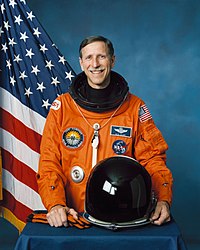Richard O. Covey
| Richard Covey | |
|---|---|

|
|
| Country: | United States |
| Organization: | NASA |
| selected on | January 16, 1978 ( 8th NASA Group ) |
| Calls: | 4 space flights |
| Start of the first space flight: |
August 27, 1985 |
| Landing of the last space flight: |
December 13, 1993 |
| Time in space: | 26d 21h 9min |
| retired on | July 1, 1994 |
| Space flights | |
Richard Oswalt Covey (born August 1, 1946 in Fayetteville , Arkansas , USA ) is a former American astronaut . Covey received a bachelor's degree in engineering with a major in aerospace engineering from the United States Air Force Academy in 1968 and a masters degree in aerospace from Purdue University in 1969 .
As a member of the US Air Force , Covey was a fighter pilot from 1970 to 1974 and flew a total of 339 combat missions in Vietnam. Between 1975 and 1978 he was used as a test pilot at Eglin Air Force Base in Florida.
Astronaut activity
In January 1978, Covey was selected by NASA as an astronaut candidate. He was the pilot of the T-38 observation aircraft for the second and third space shuttle flights and a member of the support team for the STS-5 shuttle mission . Covey was also the liaison speaker ( CAPCOM ) for the shuttle missions STS-5, STS-6 , STS-61-B , STS-61-C and STS-51-L (the Challenger accident). In 1989 he was a member of NASA's Space Flight Safety Panel. In addition to other technical tasks in the astronaut office, he was deputy head of the astronaut office and deputy director of flight crew operations.
STS-51-I
As a pilot of the space shuttle Discovery , Covey took off on August 27, 1985 for its first flight into space . The five-man crew put three communications satellites into orbit. In addition, a defective satellite launched on the STS-51-D mission was captured, repaired and then relocated. To this end, two space exits were carried out by his astronaut colleagues James van Hoften and William Fisher .
STS-26
On September 29, 1988, Covey took off again as a pilot of the Discovery into space. After an interruption of over two and a half years caused by the Challenger disaster , the shuttle program was resumed with this mission. In addition to conducting a large number of experiments of all kinds, the mission exposed the TDRS-3 communications satellite . The landing took place on schedule at Edwards Air Force Base , California .
STS-38
As commander of the space shuttle Atlantis , Covey started on November 15, 1990 for the STS-38 mission on behalf of the US Department of Defense . A military spy satellite was deployed as a payload.
STS-61
Covey flew into space for the fourth time on December 2, 1993 as commander of the space shuttle Endeavor . It was the Hubble Space Telescope's (HST) first repair mission . The main mirror of the observatory, which had started three and a half years earlier, was faulty, which led to blurred images. It took five Spacecraft Operations (EVAs) and four astronauts to install the COSTAR correction instrument and WF / PC-II camera. In addition, the solar panels used to power the HST were replaced.
According to NASA
In 1994, Covey retired from NASA and the Air Force. After the Columbia disaster , he headed the Stafford Covey Commission, which dealt with the resumption of space shuttle flights, along with retired Air Force Lieutenant General and former astronaut Tom Stafford .
From January 1998, Covey was Deputy Program Director at Boeing and, from February 2006, Deputy General Manager and Head of Operations at United Space Alliance (USA). On September 28, 2007 he then took over the post of President and Managing Director of United Space Alliance from Michael McCulley , his previous position was taken over by Daniel Brandenstein . On March 26, 2010, Covey resigned as President and CEO.
Private
Richard Covey is married with two children.
See also
Web links
- Short biography of Richard O. Covey at spacefacts.de
- NASA biography of Richard O. Covey (English; PDF)
- Biography of Richard O. Covey in the Encyclopedia Astronautica (English)
Individual evidence
- ^ Richard O. Covey to Retire as USA President & CEO. SpaceRef, March 7, 2010, accessed March 3, 2016 .
| personal data | |
|---|---|
| SURNAME | Covey, Richard O. |
| ALTERNATIVE NAMES | Covey, Richard Oswalt |
| BRIEF DESCRIPTION | American astronaut |
| DATE OF BIRTH | August 1, 1946 |
| PLACE OF BIRTH | Fayetteville (Arkansas) , Arkansas, USA |